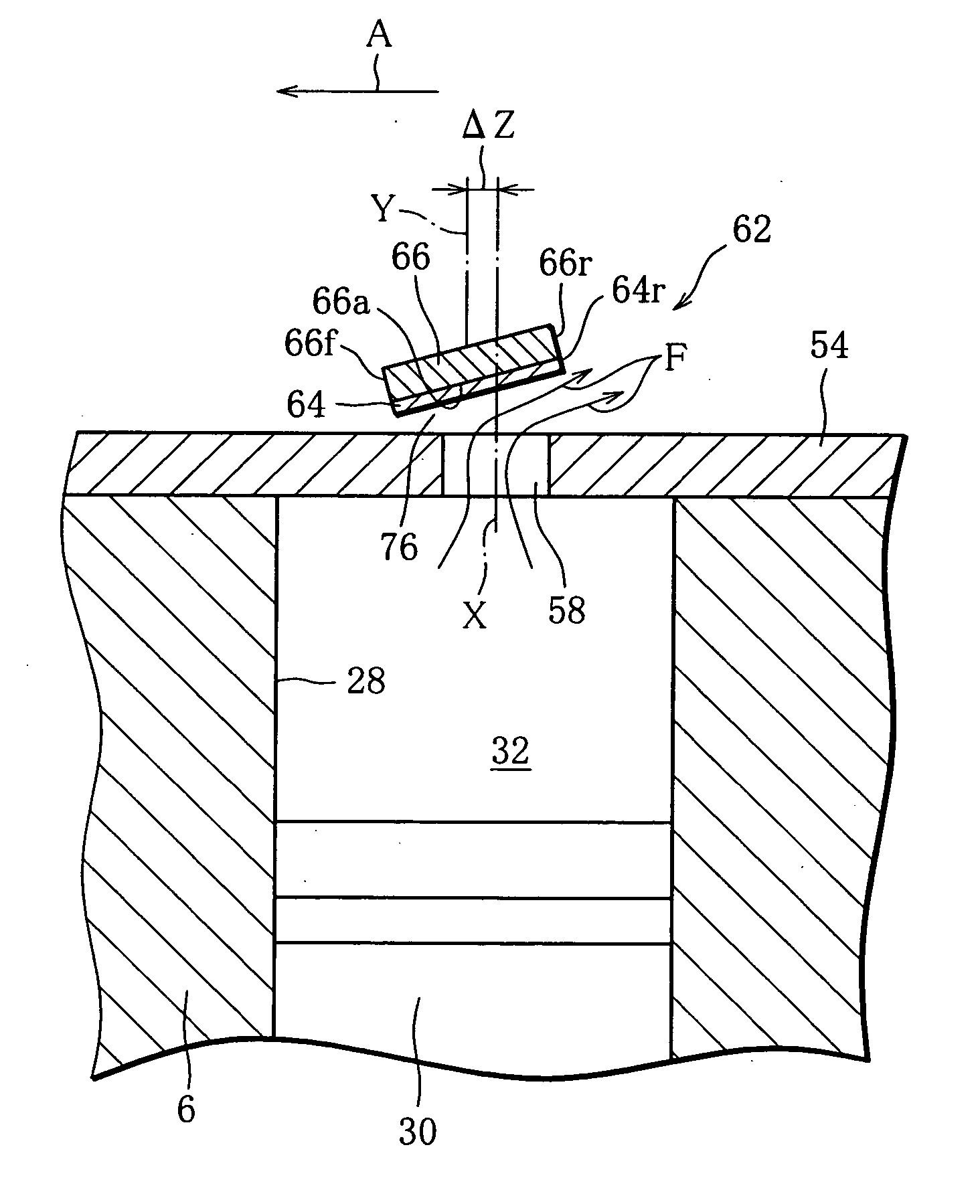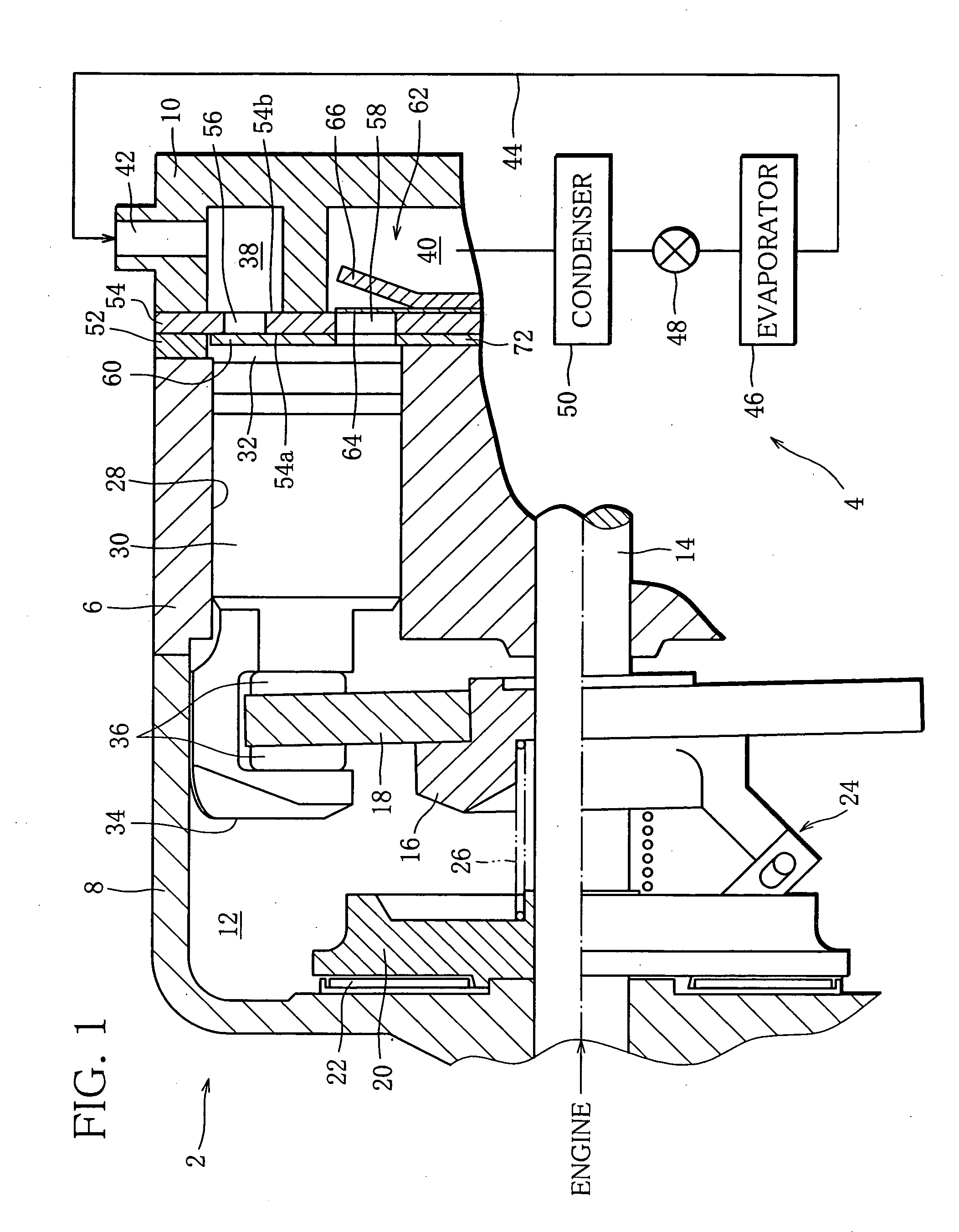Multi-cylinder reciprocating compressor
a reciprocating compressor and multi-cylinder technology, applied in the direction of machines/engines, liquid fuel engines, positive displacement liquid engines, etc., can solve the problems of reducing the compression efficiency of the compressor, the valve reed is insufficiently twisted, and the valve reed is difficult to bring the valve reed into satisfactorily close contact with the stopper surface of the retainer, so as to achieve stable opening/closing operation of the valve reed
- Summary
- Abstract
- Description
- Claims
- Application Information
AI Technical Summary
Benefits of technology
Problems solved by technology
Method used
Image
Examples
first embodiment
[0054] Each discharge hole 58 and its corresponding discharge valve 62 cooperatively constitute a discharge valve device of the present invention. In the discharge valve device the discharge hole 58 is circular in shape, as clearly shown in FIG. 2. The axis X of the discharge hole 58 (the center of gravity of the cross section of the discharge hole 58) is shifted from the center Y of the valve reed 64 in the width direction thereof by a predetermined distance ΔZ toward the side edge 64r of the valve reed 64 corresponding to the side edge 66r of the retainer 66.
[0055] Accordingly, when the valve reed 64 lifts from the valve plate 54 to open the discharge hole 58 while being elastically deformed by the pressure of the compressed refrigerant in the compression chamber 32, the flow of the refrigerant discharged from the discharge hole 58 collides mainly against one side portion of the valve reed 64 between the center Y in the width direction of the valve reed 64 and the side edge 64r. ...
second embodiment
[0058]FIGS. 4 and 5 illustrate discharge valve devices according to a
[0059] Each discharge valve device of the second embodiment has a discharge hole 78 with a pear-shaped cross section, in place of the discharge hole 58. More specifically, the cross section of the discharge hole 78 has a small-diameter end and a large-diameter end separated from each other in the width direction of the valve reed 64, and the large-diameter end is located on the same side as the side edge 64r of the valve reed 64. Like the discharge hole 58, therefore, the center X of gravity of the cross section of the discharge hole 78 is shifted from the center Y of the valve reed 64 in the width direction thereof by the predetermined distance ΔZ toward the side edge 64r of the valve reed 64.
[0060] Accordingly, when the valve reed 64 is lifted, the flow of the refrigerant discharged from the discharge hole 78 positively applies twisting moment to the valve reed 64 and thereby assists the twisting of the valve re...
third embodiment
[0061]FIG. 6 illustrates discharge valve devices according to a
[0062] Each discharge valve device of the third embodiment has a circular discharge hole 80, like the discharge hole 58, but the axis X (center of gravity) of the discharge hole 80 and the center Y of the valve reed 64 in the width direction thereof are located in a common plane. In the third embodiment, therefore, the flow of the refrigerant discharged from the discharge hole 80 collides uniformly against the distal end portion of the valve reed 64.
[0063] However, in the third embodiment, the valve reed 64 has a bay portion 82 at the side edge 64r thereof. The bay portion 82 is located between the distal end portion and root of the valve reed 64 and decreases the width of the valve reed 64.
[0064] The bay portion 82 of the valve reed 64 serves to displace a twist axis TA of the valve reed 64 from the center Y in the width direction thereof toward the side edge 64f. Accordingly, the axis X of the discharge hole 80 is ev...
PUM
 Login to View More
Login to View More Abstract
Description
Claims
Application Information
 Login to View More
Login to View More - R&D
- Intellectual Property
- Life Sciences
- Materials
- Tech Scout
- Unparalleled Data Quality
- Higher Quality Content
- 60% Fewer Hallucinations
Browse by: Latest US Patents, China's latest patents, Technical Efficacy Thesaurus, Application Domain, Technology Topic, Popular Technical Reports.
© 2025 PatSnap. All rights reserved.Legal|Privacy policy|Modern Slavery Act Transparency Statement|Sitemap|About US| Contact US: help@patsnap.com



